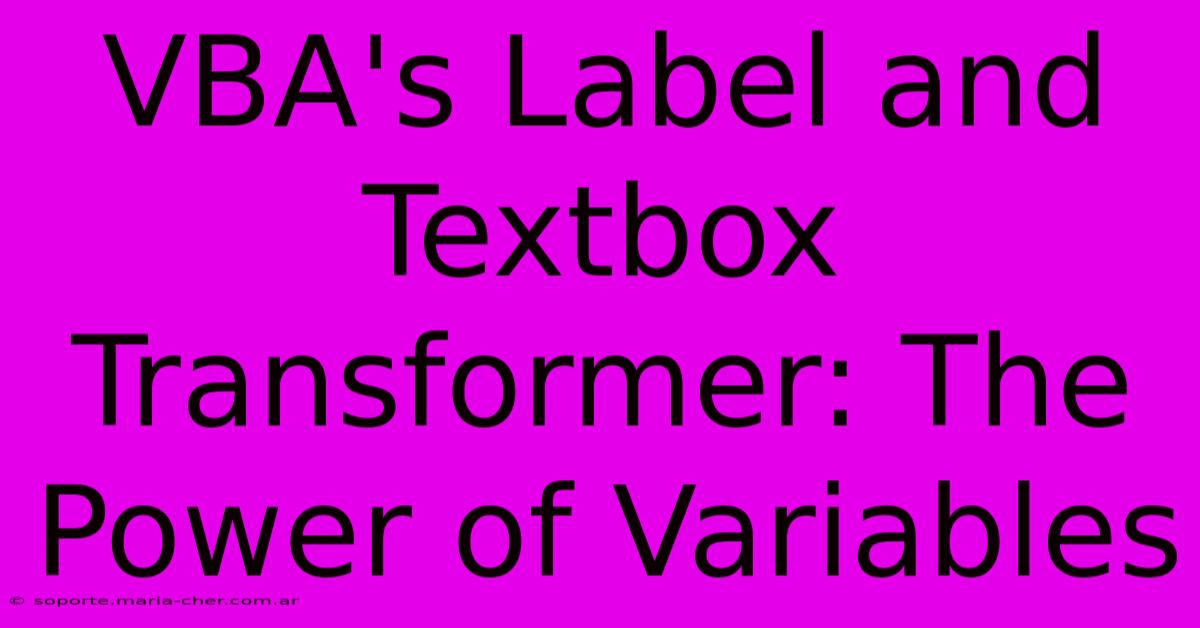VBA's Label And Textbox Transformer: The Power Of Variables

Table of Contents
VBA's Label and Textbox Transformer: The Power of Variables
Harnessing the power of variables in VBA can significantly enhance the functionality and dynamism of your userforms. This article delves into how you can leverage variables to transform the way you interact with Labels and Textboxes within your VBA projects, moving beyond static displays to create truly responsive applications.
Understanding the Foundation: Labels and Textboxes
Before diving into the power of variables, let's briefly review the core components:
-
Labels: These are static display elements; they show information to the user but don't allow direct user input. Think of them as read-only fields.
-
Textboxes: These allow users to input and edit text. They are interactive elements crucial for data collection in your VBA applications.
While seemingly simple, the real magic lies in how we connect these elements with variables, allowing us to dynamically control their content and behavior.
Dynamic Updates with Variables
The core advantage of using variables with Labels and Textboxes lies in their ability to dynamically update the displayed information. Instead of hardcoding values directly into the control's Caption (for Labels) or Value (for Textboxes) properties, we use variables. This makes our code more flexible, maintainable, and easier to modify.
Here's a simple example demonstrating how to dynamically update a Label's caption:
Sub UpdateLabel()
Dim userName As String
userName = "John Doe" ' Or get this from a user input
UserForm1.Label1.Caption = "Welcome, " & userName & "!"
End Sub
This code snippet takes a userName variable, and uses it to construct the Label's caption. Changing the userName variable instantly updates the Label's display without modifying the code itself.
Enhancing Textbox Functionality
Variables empower Textboxes beyond simple data entry. For instance, you can use variables to:
- Pre-populate Textboxes: Instead of leaving Textboxes blank, initialize them with default values stored in variables.
- Validate User Input: Variables can store validation rules, allowing you to check the format and content of user input before processing.
- Create Calculated Fields: Use variables to perform calculations based on user input in multiple Textboxes, displaying the result in another Textbox or Label.
Sub CalculateSum()
Dim num1 As Double, num2 As Double, sum As Double
num1 = CDbl(UserForm1.TextBox1.Value)
num2 = CDbl(UserForm1.TextBox2.Value)
sum = num1 + num2
UserForm1.TextBox3.Value = sum
End Sub
This code adds two numbers entered by the user and displays the sum. The variables num1, num2, and sum make the calculation clear and easily modifiable.
Advanced Techniques: Arrays and Collections
For more complex scenarios involving multiple Labels or Textboxes, consider using arrays or collections. This structured approach allows you to efficiently manage and manipulate numerous controls using loops and iterations.
For example, you could use an array to store the values from multiple Textboxes and then process them all at once.
Error Handling and Robustness
Remember to incorporate error handling into your code. This includes checking for invalid user input (e.g., non-numeric values in Textboxes intended for numbers) and handling potential runtime errors. Robust error handling prevents unexpected crashes and ensures a smoother user experience.
Conclusion: Unlocking the Potential
Mastering the use of variables with VBA's Labels and Textboxes is key to building dynamic and user-friendly applications. By moving beyond static displays and embracing the power of variables, you'll create more flexible, maintainable, and robust VBA projects. Experiment with different approaches, and you'll discover the transformative potential of variables in your VBA development.

Thank you for visiting our website wich cover about VBA's Label And Textbox Transformer: The Power Of Variables. We hope the information provided has been useful to you. Feel free to contact us if you have any questions or need further assistance. See you next time and dont miss to bookmark.
Featured Posts
-
8 M Politico Subscriptions Cut By White House
Feb 06, 2025
-
The Mystical Orange Rose A Manifestation Of Renewal Abundance And Warmth
Feb 06, 2025
-
Masters Of Monochrome Meet The Legendary Black And White Photographers
Feb 06, 2025
-
15 Valentines Day Gifts And Dates 2025
Feb 06, 2025
-
Bunting Bonanza Get Inspired By The Rainbow Of Color Codes
Feb 06, 2025
